Teaching is one of the most underpaid and underappreciated professions. Two out of three Americans agree that teachers deserve to be paid more. If you’re a public school teacher, you’re probably all too familiar with the fight for higher wages. [1]
Whether you became a teacher to work with kids, share your passion for a certain subject or make a difference for future generations, it’s unlikely that you do it for the salary. But with the growing gig economy and the availability of remote work, you can supplement your income to make well above the average teaching salary.
In the past, pursuing National Board Certification, graduating with an advanced degree or getting a part-time summer job were the only options for boosting your income. Now, teachers are becoming millionaires by selling lesson plans, teaching students overseas or freelance writing—all thanks to the Internet and social media.
Take 32-year-old Hadar Hartstein, for example. Over the past six years, she’s sold a variety of teaching materials online like lesson plans, flash cards and ideas for classroom activities through her business Miss Kindergarten. And she’s earned more than $1 million. [2] It’s undoubtedly a lot of work to create so many offerings, but if Hadar’s Miss Kindergarten story tells you anything, it’s that selling lesson plans online is a great side hustle.
5 Ways Teachers Can Earn Extra Income
To learn more about how to earn extra income, check out these five ideas and pick one that suits your strengths and interests.
- Sell Teaching Resources Online
- Teach English to Students Overseas
- Start a Tutoring Business
- Write eBooks
- Write Freelance Articles

New online marketplaces provide a hub for educators to buy, sell and share lesson plans and activities for the classroom. Some of the most popular platforms include Teachers Pay Teachers, Teacher Lingo and Etsy. According to Adam Freed, an executive board member and former CEO of Teachers Pay Teachers, two-thirds of teachers in the U.S. are active members of the site. [3]
Step 1: Choose the Types of Products You Want to Sell
You can offer as much variety as you’d like or specialize in creating one type of resource. The beauty of online platforms is that you can create the things you enjoy and source other types of content from fellow teachers.
- Lesson plans
- Worksheets
- Lectures/presentations
- Flash cards
- Puzzles
- Projects
- Posters
- Craft kits
- Classroom decorations
Step 2: Create Your Products
Whether you’re design-savvy or not, you can create beautiful educational resources using anything from basic word processing tools to design software like the Adobe Creative Cloud.
- Microsoft Office: Good if you want to create basic worksheets.
- Google Drive: Good if you want to create online resources.
- Canva: Good if you’re a beginner designer.
- Adobe Creative Cloud: Good if you want full design control over the final product.
However you choose to make your products, print a few versions for yourself to test out since colors can often look different on paper than the computer screen.
Step 3: Pick a Platform to Sell Your Products
Before deciding which platform is best for you, consider factors like how much it costs to join, how much the site keeps per transaction and how often you get paid.

[4][5]
Step 4: Market Yourself
Once you’ve decided on a platform, it’s time to post your offerings and let the world know. Sharing is the first step to success:
- Promote your resources on social media. Twitter, Instagram and Pinterest are great starting points.
- Create a blog or website. Sites like Squarespace and WordPress make this quick and easy with dozens of customizable templates.
- Offer occasional sales and giveaways. Seasonal sales or giveaways around events like back to school or Teacher Appreciation Day help boost traffic.
- Include photos of your resources in action. Photos lend credibility to your products and help potential buyers understand how to use them.
- Team up with other teachers to cross-promote your resources. Find a friend who offers products that complement yours and share each other’s products on social media or do a bundle giveaway.

If connecting with kids is your passion, there’s no reason you can’t extend that beyond the classroom. There are plenty of ways to use online learning platforms to educate kids who aren’t in your immediate area.
Teaching English as a second language (ESL) to students in in another country is a great way to make part-time or even full-time income. One of the most commonly used platforms, VIPKid, was ranked number one in Forbes’ 2018 Top 100 Remote Work Companies Report. The students typically range in age from 4 to 12 years old. If this is something that interests you, be sure to consider your schedule since hours need to be compatible with those of the country the child you’re teaching is in.
[6][7]

Tutoring is a natural extension of the skills you already have. Online tutoring companies or schools offer remote positions for teachers seeking work they can do from home. You can also take an entrepreneurial approach and create your own tutoring business. The average hourly pay for tutoring ranges from $10 to $40. [8] Pay varies depending on the subject matter and your expertise, but taking the entrepreneurial path typically pays more.
The biggest challenge is finding students to tutor. So, here are a few tips for advertising your services:
- Tap your network. Friends, neighbors and coworkers are all great referral sources.
- Make business cards. Hand them out if anyone asks about your tutoring business.
- Post brochures or small posters in the community. Find frequented areas like the library, coffee shops or grocery stores, or on sites like Nextdoor.
If you prefer to stick with online tutoring, here are a few platforms you can use:

In the past, you needed a deal with a publishing house to publish a book, but with the popularity of eBooks, self-publishing is a great option for aspiring writers. If you feel like you have something to share, offer it as in eBook! Digital products like e-books do require work upfront, but with the right marketing strategy, sales keep coming one your book is done.
Step 1: Pick a Topic
Nonfiction is the most obvious route for teachers looking to offer an informational product. Maybe you have a teaching method that you’re really passionate about, or maybe you have a unique experience as a teacher. Those are great topics for an eBook. Here are a few ideas to get the creative juices flowing:
- Back-to-school guide
- Test prep tips
- Conquering test anxiety
- How to make studying fun
- Classroom management tips and tricks
- Seasonal classroom activities
- Planning for your first year of teaching
Step 2: Format Your Book
You can use whatever platform you want to create your book, but there are a few specialty tools out there made specifically for creating eBooks. Also, check out step two of selling teaching resources for some additional tools you can use.
Step 3: Publish Your Book
No matter how you create your book, there are two formats to export it in depending on which publishing platform you choose. Use .mobi for Amazon and .ePub for the other stores. If you have a website, you can also offer a .pdf version of your book for people who subscribe to your site via email.

If writing and formatting an eBook feels like too much commitment right now, consider writing freelance articles. There are plenty of teaching blogs and websites that pay contributing writers for their work. You can write about e-book-worthy topics, but in a more bite-sized format.
- WeAreTeachers
- School Leaders Now
- Teachers & Writers Magazine
- American School Board Journal
- American Educator
- Kappan Magazine
How Teachers Can Spend Less and Save More
Teachers are expected to teach future generations about money, but as a teacher, you need money management tips as much as the next person—maybe even more considering that, as a teacher, you might earn less than professionals with similar education levels. [9] From taking advantage of special discounts to finding free or cheap ways to get classroom supplies, there are plenty of ways to spend less and save more.
Teacher Discounts, Tax Deductions and More
- Claim the Educator Expense Deduction on your taxes. The Educator Expense Deduction is the largest tax break available for teachers. If you’re among the 94% of public school teachers who pay out of pocket to enrich your classroom [10], you can reduce your taxable income by $250.
- Set up a 403(b) plan and/or Roth IRA. Besides public pension plans—which have become a rarity—403(b) plans let you save pretax income for retirement. Limited investment options make them attractive, but if your school matches 403(b) contributions, choose the best mutual fund to invest in and contribute enough to receive the full match. Invest any additional retirement savings in a Roth IRA.
- Plan for additional taxes. If you plan to sell educational resources, allott an extra 15% or more to pay for self-employment taxes on anything you make as a freelancer or resource outside of school.
- Build up emergency savings in case of a teacher strike. For public school teachers, participating in strikes and walkouts means forgoing income. If you feel strongly about participating in a strike, savings will give you some peace of mind.
- Find out if you’re eligible for student loan reduction or forgiveness. There are four main ways for teachers to receive student loan forgiveness: Public Service Loan Forgiveness, Teacher Loan Forgiveness, Perkins Teacher Loan Forgiveness and State-Based Loan Repayment Assistance Programs. If you want more details on how to qualify for these programs, check out the U.S. Department of Education’s blog post on the subject.
- Make the most of teacher discounts. From craft supplies and books to travel and clothing, educators can get special discounts on all sorts of things. Many retailers offer them, so the best way to find out whether your favorite stores have a discount is to search through a full list of teacher discounts or simply ask at checkout.
Thrifty Ways to Buy Classroom Supplies
- Pick a credit card that earns you cash back on supplies. If you frequently buy classroom supplies, you can maximize your savings by earning cash back on your purchases. Consider the Chase Sapphire Preferred as a teachers or learn more about the best credit cards to help teachers stock their classrooms.
- Borrow before you buy. Ask around to see if a fellow teacher has what you need or consider trading supplies online at HootofLoot.
- Ask for classroom donations. Ask for donations at the beginning of each school year when you send your students a supply list, but if you’re running low on the essentials, don’t be afraid to request a fresh supply.
- Ask local businesses for classroom donations. Some local businesses are willing to sponsor a classroom by donating supplies. Do some research or tap your network to find out how this works in your area.
- Seek out grants and supply donation programs.
By selling your teaching resources or tutoring services, you can build a personal brand, connect with the larger teaching community and make some extra money all at once. The same reasons you became a teacher mean you probably put your students first. but it’s important that you take care of you—and that includes your finances. If you’re not sure where you stand, check your credit score for free to make sure you’re in good financial standing, or at least know what you need to work towards.

At publishing time, the Chase Sapphire Preferred card is offered through Credit.com product pages, and Credit.com is compensated if our users apply and ultimately sign up for this card. However, this relationship does not result in any preferential editorial treatment. This content is not provided by the card issuer(s). Any opinions expressed are those of Credit.com alone, and have not been reviewed, approved or otherwise endorsed by the issuer(s).
Note: It’s important to remember that interest rates, fees and terms for credit cards, loans and other financial products frequently change. As a result, rates, fees and terms for credit cards, loans and other financial products cited in these articles may have changed since the date of publication. Please be sure to verify current rates, fees and terms with credit card issuers, banks or other financial institutions directly.
Sources:
1 PDK Poll Teaching: Respect but dwindling appeal
2 Business Insider Teachers are making millions selling their lessons plans online
3 PBS NewsHour Why teachers selling lesson plans have sparked debate
4 Teachers Pay Teachers Payout Rates and Fees
5 The Work at Home Wife 5 Places to Sell Teaching Materials Online
6 WeAreTeachers 12 Rewarding Ways Teachers Can Work From Home
8 PayScale Average Tutor Hourly Pay
9 Money These 7 Charts Explain the Fight for Higher Teacher Pay
10 U.S. Department of Education Public School Teacher Spending on Classroom Supplies
You Might Also Like
March 11, 2021
Personal Finance
March 1, 2021
Personal Finance
February 18, 2021
Personal Finance






